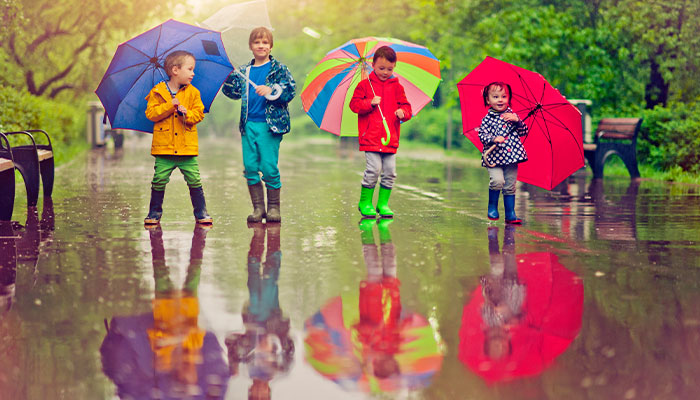While we believe that the books and resources recommended may be of value to you, keep in mind that these are suggestions only and you must do your own due diligence to determine whether the materials are appropriate and suitable for your use. PNC has no sponsorship or endorsement agreement with the authors or publishers of the materials listed.
WEATHER

Make A Rain Gauge
Children will measure rain fall.

Lesson Objective
Children will make a rain gauge to collect and measure rainfall.
Science
What You'll Need
- A rainy day
- Two-liter bottles – 4
- Scissors or utility knife – adult use
- Duct tape – 1 roll
- Permanent markers
- Rulers
What To Do
Note: You may need to engage additional adult help for the children with marking the measurements on the sides of the bottles.
- Discuss the amount of rain that is falling from the sky.
- Tell the children that there is usually more rainfall in the spring as the temperature begins to get warmer (see Did You Know?).
- Tell children they are going to find out how much water is falling from the sky when it rains.
- Display the two-liter bottles. Ask children if they think much rain would fall into the small opening of the bottle.
- Ask the children for their ideas on how they could change the bottles to collect more rain.
- Using the scissors or utility knife, cut around the top of the bottle where it starts to curve in.
- Take the top of the bottle and invert it to use as a funnel, and place it on top of the bottle. Attach the funnel to the bottle with some duct tape.
- Use the permanent markers and rulers to mark measurements on the side of the bottle in half-inch increments.
- Take the rain gauges outside and place them in a location where they will not easily tip over.
- Observe the rain gauges after each rain, measure and chart the amount of water each time.
Resources
Home School Resources
Home educators: use these printable lesson PDFs to teach this lesson to your home schoolers. They're available in English and Spanish.
Content Provided By
Common Core State Standards Initiative – These lessons are aligned with the Common Core State Standards ("CCSS"). The CCSS provide a consistent, clear understanding of the concepts and skills children are expected to learn and guide teachers to provide their students with opportunities to gain these important skills and foundational knowledge [1]. Visit the CCSS


